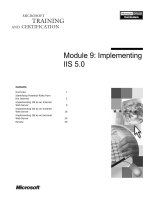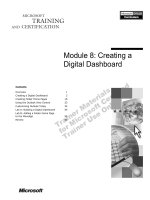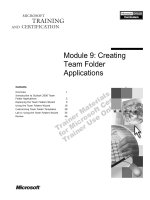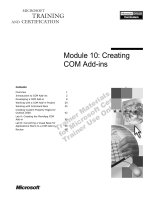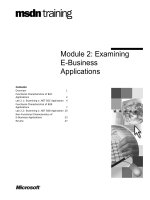Tài liệu Module 9: Creating Team Folder Applications pptx
Bạn đang xem bản rút gọn của tài liệu. Xem và tải ngay bản đầy đủ của tài liệu tại đây (944.95 KB, 52 trang )
Contents
Overview 1
Introduction to Outlook 2000 Team
Folder Applications 2
Deploying the Team Folders Wizard 9
Using the Team Folders Wizard 18
Customizing Team Folder Templates 28
Lab A: Using the Team Folders Wizard 35
Review 46
Module 9: Creating
Team Folder
Applications
Information in this document is subject to change without notice. The names of companies,
products, people, characters, and/or data mentioned herein are fictitious and are in no way intended
to represent any real individual, company, product, or event, unless otherwise noted. Complying
with all applicable copyright laws is the responsibility of the user. No part of this document may
be reproduced or transmitted in any form or by any means, electronic or mechanical, for any
purpose, without the express written permission of Microsoft Corporation. If, however, your only
means of access is electronic, permission to print one copy is hereby granted.
Microsoft may have patents, patent applications, trademarks, copyrights, or other intellectual
property rights covering subject matter in this document. Except as expressly provided in any
written license agreement from Microsoft, the furnishing of this document does not give you any
license to these patents, trademarks, copyrights, or other intellectual property.
1999 Microsoft Corporation. All rights reserved.
Microsoft, Active Desktop, Active Directory, ActiveX, BackOffice, Developer Studio, FrontPage,
JScript, MSDN, MSN, NetMeeting, Outlook, PivotChart, PivotTable, PowerPoint, Visual Basic,
Visual C++, Visual FoxPro, Visual InterDev, Visual J++, Visual SourceSafe, Visual Studio,
Windows, Windows Media, and Windows NT are either registered trademarks or trademarks of
Microsoft Corporation in the U.S.A. and/or other countries.
The names of companies, products, people, characters, and/or data mentioned herein are fictitious
and are in no way intended to represent any real individual, company, product, or event, unless
otherwise noted.
Other product and company names mentioned herein may be the trademarks of their respective
owners.
Project Advisor: Janet Wilson
Project Lead and Instructional Designer: Anne Bockman (Excell Data Corporation)
Instructional Designers: Josh Barnhill (Volt Technical) and Jo Berry (Exchange)
Lead Program Manager: Greg Bott
Program Managers: Colleena Carr and Chris Boar (Intl Vendor)
Graphic Artist: Andrea Heuston (Artitudes Layout and Design)
Editing Manager: Lynette Skinner
Editor: Jennifer Kerns (S&T Onsite)
Copy Editor: Shari G. Smith (R & S Consulting)
Online Program Manager: Arlo Emerson (Aditi)
Production Support: Irene Barnett (Barnett Communications)
Manufacturing Manager: Bo Galford
Manufacturing Support: Mimi Dukes (S&T Onsite)
Development Services: Kimber Dodge
Lead Product Manager: Mary Larson
Group Product Manager: Robert Stewart
Module 9: Creating Team Folder Applications iii
Instructor Notes Module 9: Creating Team Folder
Applications
This module provides students with an introduction to Microsoft
®
Outlook
®
team folders.
At the end of this module, students will be able to describe how team folders
can be used in a collaborative solution. They will also be able to use the Team
Folders Wizard and deploy this tool to other users.
Materials and Preparation
This section provides you with the materials and preparation needed to teach
this module.
Materials
To teach this module, you need the following materials:
Microsoft PowerPoint
®
file 1593a_09.ppt
Module 9, “Creating Team Folder Applications”
Preparation
To prepare for this module, you should:
Read all the materials for this module.
Read the instructor notes and margin notes for the module.
Complete the lab.
Presentation:
45 Minutes
Lab:
30 Minutes
iv Module 9: Creating Team Folder Applications
Module Strategy
Use the following strategy to present this module:
Introduction to Outlook 2000 Team Folder Applications
Describe the benefits of creating team folder applications. Define the Team
Folders Wizard, the tool used to create team folder applications. Describe
the different types of applications that students can create and list the
common features found in all team folder applications.
Deploying the Team Folders Wizard
Describe the steps students should following when deploying the Team
Folders Wizard to users. Steps include ensuring that network and user
requirements are met, preparing the network server by making sure that all
of the files that are required by the user to use the Team Folders Wizard are
available, and customizing the default installation addresses for the wizard
so that users are not required to type them manually.
Using the Team Folders Wizard
Cover each step of the Team Folders Wizard and explain the options that are
available. Describe the issues relating to the location of the team folder
application and the Web site where files are posted to support the
application. Show how to invite members to use a team folder application
and describe what is required to deploy team folders to users.
Customizing Team Folder Templates
Explain how to deploy an application as a Team Folder Wizard custom
template and register the template.
Module 9: Creating Team Folder Applications 1
Overview
Introduction to Outlook 2000 Team Folder Applications
Deploying the Team Folders Wizard
Using the Team Folders Wizard
Customizing Team Folder Templates
At the end of this module, you will be able to:
Describe the capabilities of Microsoft
®
Outlook
®
2000 team folders and
define the various applications that you can create by using the Team
Folders Wizard.
Perform the steps required to deploy the Team Folders Wizard to users.
Create team folder applications by using the Team Folders Wizard and then
deploy them.
Distribute custom Outlook 2000 solutions by creating a custom Team
Folder Template.
Slide Objective
To provide an overview of
the module topics and
objectives.
Lead-in
In this module, you will learn
about developing team
folder applications for
Outlook 2000. By using the
Team Folders Wizard, you
can move beyond basic
public folders to develop full-
featured collaborative
solutions for Outlook 2000.
2 Module 9: Creating Team Folder Applications
Introduction to Outlook 2000 Team Folder
Applications
Benefits of Team Folder Applications
Components Common to Team Folder Applications
Team Folder Templates
Team folder applications are customized, collaborative applications that can
manage workgroup and enterprise information. Team folders provide a Web-
style user interface, combined with the collaborative features of Outlook 2000
and Microsoft Exchange Server.
You can create team folder applications by using the Team Folders Wizard, in
combination with Outlook 2000 and Exchange Server. The Team Folders
Wizard is an extensible Component Object Model (COM) add-in for
Outlook 2000 that provides a simple user interface and set of collaborative
applications. The Team Folders Wizard requires no programming to create
applications for discussion groups, issue tracking, calendar sharing, and contact
and task tracking. In addition, the folder home pages created by the wizard offer
a great starting point for the customization of your own folder home pages.
Using the Team Folders Wizard is an easy way for users to create collaborative
applications without administrative assistance.
Slide Objective
To outline this topic.
Lead-in
Team Folder applications
enable you to quickly build
full-featured collaborative
solutions, without requiring
custom programming.
Delivery Tip
Reinforce the point that
Outlook 2000 team folder
applications are not
intended for some
administrative tasks (such
as creating public folders).
They are intended to be an
end-user tool. Clarify that
the administrator is typically
responsible for setting up
the Team Folders Wizard for
use by team leader(s).
Module 9: Creating Team Folder Applications 3
Benefits of Team Folder Applications
Sharing Information Among Workgroups
Browsing a Web-like User Interface
Notifying Users About New Applications
Accessing Applications by Using Exchange Server
Controlling Application Data and Permissions
Team folder applications created by using the Team Folders Wizard,
Outlook 2000, and Exchange Server provide the benefits as listed in the
following text.
Sharing Information Among Workgroups
Because Team Folder applications exist within the Exchange Server public
folder infrastructure, these applications and the information they manage are
automatically shared among users in a workgroup or are replicated throughout
an enterprise. Administrators retain control over user access and level of
permissions.
Browsing a Web-like User Interface
Folder home pages provide users with a Web-like interface to collaborative
applications. Folder home pages can provide user assistance and display
summaries of application information. In addition, folder home pages provide
an intuitive interface to application features and commands.
Notifying Users About New Applications
Users can automatically be informed of a newly deployed application by an
embedded hyperlink in an e-mail message. This link can easily be added to their
Outlook Bar. Users can access applications by clicking the shortcut in the
Outlook Bar or from the Outlook 2000 folder list. They can also access
applications by using Microsoft Internet Explorer.
Accessing Applications by Using Exchange Server
Users can access applications when they are offline by using Exchange Server.
Any changes made to information while offline is synchronized with Exchange
Server when the user goes back online. Application information can be
synchronized online in the background with optional filtered synchronization,
so that only relevant information takes up space on the user’s local hard disk.
Slide Objective
To describe the benefits of
developing team folder
applications.
Lead-in
Team folder applications
created by using Team
Folders Wizard,
Outlook 2000, and
Exchange Server offer many
benefits to developers.
4 Module 9: Creating Team Folder Applications
Controlling Application Data and Permissions
Administrators have control of application data backup and application access
permissions by using comprehensive Exchange Server administration tools.
Additionally, by using the team folder application interface, you can add new
team members only once and have the change propagate through all of the
folders in the application.
Module 9: Creating Team Folder Applications 5
Components Common to Team Folder Applications
Team Folder Administration Page
Team folder
Administration folder
Team Folder Home Pages
Navigation links
Show Me
Find
Commands for creating new items
Other application-specific commands
Welcome Page
The Team Folders Wizard can be used to create seven different types of team
folder applications, with a template provided for each application. All of the
Team Folder templates share a set of features that provide a common
application infrastructure, such as an Administration page, folder home pages,
and a Welcome page.
Team Folder Administration Page
In each application, the following two template subfolders maintain
administrative information:
Team folder. This folder contains an Outlook 2000 contact item for each
member of the team using the application. The home page for this folder
enables the administrator to add new team members, send a mail message to
all of the team members, categorize team members, and so on.
Administration folder. This folder contains forms used to send messages or
to manage text displayed by the application home page. The folder home
page of the Administration folder is a wizard-like tool that the application’s
administrator (usually the user who created the team folder) uses to manage
the application.
Slide Objective
To list and describe the
common components in the
Team Folder template
applications.
Lead-in
The Team Folder template
applications automatically
provide the infrastructure to
help users navigate through
and use a team folder
application.
6 Module 9: Creating Team Folder Applications
Team Folder Home Pages
A folder home page guides users through the functions of the application and
provides easy access to Help and other resources. The top-level folder of a team
folder application contains a folder home page that functions as the home page
for the entire application. Additionally, each folder within the team folder
application contains its own folder home page with information that is specific
to the type of item that is contained there. Each folder home page contains:
Navigation links. The folder home page displays links at the top of the
browser window. The user can click the links to display the folder home
page for each folder within the application.
Show Me. The Show Me area lists a set of views for the items contained in
the folder. You can use these views or create your own custom views.
Find. You can use this feature to locate specific items within the folder.
Commands for creating new items. Each application enables users to create
three types of items:
• Default item for that application (for example, in the Team Tasks
application, create an Outlook 2000 task item).
• E-mail item to the application administrator.
• E-mail item to all team members.
Other application-specific commands. The folder home page displays
commands that are specific to the type of item stored in the folder. For
example, in the Team Calendar application, you can click Go to Today to
display the calendar for the current day.
The home page uses the Outlook view control to provide folder views and
access to the items in the subfolders. This control is available for use in other
Web pages as well as in Microsoft Visual Basic
®
or Microsoft Visual Basic for
Applications forms.
Welcome Page
The Welcome page contains a message that welcomes users to the application
and can also provide a general overview of the team folder. You can use the
Top News area to keep users up-to-date on the team’s activities or to provide
other current information.
This page also contains links to general information about the application and a
list of resources where users can find more information about the application.
When you access the top-level folder of a Team Project application, the
Welcome page displays. When you access the top-level folder of any other
application, the folder home page displays. You can access the Welcome page
for these applications by clicking Home on the folder home page.
Module 9: Creating Team Folder Applications 7
Team Folder Templates
Team Project
Team Contacts
Document Library
Team Tasks
Team Calendar
Discussion Forum
In addition to the Administration and Team folders that are common to all team
folder applications, each Team Folder Template contains folders that are
specific to the type of application that the template creates.
Team Project
The Team Project application contains a complete set of folders for a
collaborative project. All of the remaining team folder applications enable you
to create any of the subfolders of the Team Project application individually.
The Team Project application combines all of the following team folder
functions.
Team Contacts
By using the Team Contacts application, users can publish names, phone
numbers, addresses, and other information about customers, suppliers, partners,
or other people and organizations that are important to the team. You can view
contacts by displaying address cards, a list of all contacts, or a list of contacts
grouped by company, category, or city. You can also use an editable contacts
view.
Document Library
The Document Library application enables users to share documents by placing
them in a library available to all users. Users can view all documents or
documents grouped by author or category.
Team Tasks
By using the Team Tasks application, users can create a shared to-do list to help
team members coordinate their activities. Users can view their own tasks, all
tasks, or tasks grouped by owner or area.
Slide Objective
To list the Team Folder
Templates.
Lead-in
Approximately 75 percent of
all collaborative applications
can be built by using one of
the six Team Folder
Templates.
Delivery Tip
As you discuss each of the
Team Folder Templates,
show students how the
resulting team folder
application will appear by
showing a previously
created team folder
application.
8 Module 9: Creating Team Folder Applications
Team Calendar
By using the Team Calendar application, users can publish meetings and events
of interest to the team and send invitations to other team members so they can
add the meetings and events to their personal Outlook 2000 calendars. Users
can schedule appointments or team meetings and view the calendar for a single
day, a work week, a full week, or a full month.
Discussion Forum
The Discussion Forum application enables user to post messages that are linked
together as conversational threads. Users can post a message or reply to a
message. They can also view messages grouped by conversation or by sender,
all messages, unread messages, or unread messages grouped by conversation.
Module 9: Creating Team Folder Applications 9
Deploying the Team Folders Wizard
Components of the Team Folders Kit
Meeting Server Requirements
Meeting Team Folder Owner Requirements
Preparing the Network Servers
Customizing the Default Installation Addresses
The Team Folders Kit contains all of the files necessary to deploy and use the
Team Folders Wizard. By deploying the Team Folders Wizard within your
organization, you can enable any user with appropriate access privileges to
create team folder applications.
Deploying the Team Folders Wizard is not difficult, but it does require some
advance planning and preparation. To successfully deploy Team Folders in
your organization, you must perform each of the following steps:
1. Ensure that the network server is ready.
2. Ensure that team folders owner requirements are met.
3. Prepare the network servers. This involves publishing the invitation form in
the Organizational Forms Library and making Team Folders Wizard Setup
and supporting files available to users.
4. Customize the default installation addresses for the Team Folders Wizard.
Slide Objective
To outline this topic.
Lead-in
Any user in your
organization who has
access to public folders can
use the Team Folders
Wizard to create team folder
applications.
10 Module 9: Creating Team Folder Applications
Components of the Team Folders Kit
Invitation Form
ActiveX Controls
Outlook view control
Outlook Permissions Control
Team Folders Wizard Setup
Supporting Documentation
The Team Folders Kit contains all of the tools you need to create team folders.
The kit consists of the following four components:
An invitation form and a utility for installing the form in the Organizational
Forms Library.
Microsoft ActiveX
®
controls and utility files to allow the controls to be
accessed from an organization’s intranet.
Team Folders Wizard Setup.
Supporting documentation.
Invitation Form
Once a user creates a team folder by using one of the Outlook 2000 Team
Folders Templates, the user can send a message to team members that tells
them about the team folder and provides a button they can click to add a
shortcut to the team folder on the Outlook Bar. To prevent users from receiving
a warning about macros in the invitation message, the form must be published
in the Microsoft Exchange Server Organizational Forms Library. The Team
Folders Kit includes a personal folders file (Invite.pst) containing the form and
a utility (Vbinvite.exe) that a Microsoft Exchange Server administrator can run
to publish the form automatically.
Slide Objective
To list the components of
the Team Folders Kit.
Lead-in
The Team Folders Kit
contains an invitation form,
ActiveX controls, the Team
Folders Wizard Setup file,
and supporting
documentation.
Module 9: Creating Team Folder Applications 11
ActiveX Controls
The folder home pages of the Team Folders Templates use two ActiveX
controls, the Outlook view control and the Outlook 2000 Permissions Control.
By default, the folder home pages download these controls from the Microsoft
Web site at name
by means of an internal algorithm within Internet Explorer. However,
organizations in which users do not have access to the Internet can configure
the folder home pages to download the controls from a server on the
organization’s local area network. The Team Folders Kit includes .cab files
containing the controls and utility files (Codebase.bat and Codebase.ini) that are
used to specify the location of the source files.
Team Folders Wizard Setup
Before a team folder can be created, the user must install the Team Folders
Wizard and the Team Folders Templates. Team Folders Wizard Setup is a self-
contained executable file (Oltfwiz.exe) that a user can run from a network share
or receive as an e-mail attachment.
Supporting Documentation
Documentation includes the Team Folders Deployment and Customization
Guide, the Microsoft Outlook View Control Programmer’s Reference, and the
Microsoft Outlook Permissions Control Programmer’s Reference. This
documentation is located in the Docs folder of the Team Folders Kit installation
directory. The installation folder also contains a Readme file, which includes
information that was developed too late to be included in the guide.
12 Module 9: Creating Team Folder Applications
Meeting Server Requirements
Server Requirements
Exchange Server 5.0 or later
Public folders with owner permissions for the users who
will be using the Team Folders Wizard
A file, HTTP, or FTP server where users can create
folders and files
Web publishing support
FrontPage Server Extensions
Office 2000 Server Extensions
To support team folders created by the Team Folders Wizard, the following
server requirements should be met:
Exchange Server 5.0 or later. You must run Exchange Server version 5.0 or
later to run the Team Folders Wizard.
Public folders. Establish public folders with owner permissions for the users
who will be using the Team Folders Wizard.
A file, HTTP, or FTP server. You need to provide a server where users can
create folders and files. File Transfer Protocol (FTP) servers must have
Hypertext Transfer Protocol (HTTP) addresses mapped to the FTP
addresses where users will publish files. The following is recommended
when using HTTP or FTP servers:
• Microsoft Internet Information Server version 4.0 or later with Microsoft
FrontPage
®
98 (or later) Server Extensions.
• Other servers require FrontPage 98 (or later) Server Extensions or
Microsoft Office 2000 Web Server Extensions.
Web publishing support. You must have one of the following installed:
• FrontPage Server Extensions. Microsoft FrontPage Server Extensions
are available when you install FrontPage or the Office 2000 Server
Extensions.
• Office 2000 Server Extensions. These extensions are installed by default
with Office 2000 Standard, Professional, and Premium.
Slide Objective
To list the server
requirements of the Team
Folders Wizard.
Lead-in
The first step in deploying
the Team Folders Wizard to
users is to ensure that the
server requirements are
met.
Module 9: Creating Team Folder Applications 13
Meeting Team Folder Owner Requirements
Client Requirements
Outlook 2000 with CDO
Web Publishing Wizard
Internet Explorer 5.0 or later
Before you install the Team Folders Wizard, verify that the following
applications and components are installed on the client computer:
Outlook 2000 with CDO. Collaboration Data Objects (CDO) is an optional
Outlook 2000 component available in the Office 2000 Setup program.
Web Publishing Wizard. This is only required if you plan to publish the
team folder home pages on a HTTP server without Microsoft FrontPage
Server Extensions, or on an FTP server. This is a standard component
installed with the default Microsoft Internet Explorer 5.0 installation
available in Office 2000.
Internet Explorer 5.0 or later. Microsoft Internet Explorer 5.0 is installed by
default by the Office 2000 installation program.
Slide Objective
To describe the client
requirement for using the
Team Folders Wizard.
Lead-in
To use the Team Folders
Wizard, you must have a
number of products and
technologies installed on
your computer.
14 Module 9: Creating Team Folder Applications
Preparing the Network Servers
Publishing the Invitation Form
Making Team Folders Wizard Setup Files Available to
Users
Running the Team Folders Wizard Setup Without User
Intervention
To prepare the network servers to support Team Folder Wizard deployment and
use by users, you must make the invitation form, Team Folders Wizard Setup
files, and other supporting files available on these servers.
Publishing the Invitation Form
When users create a team folder application, they can send out an Invitation
form to team members. This form tells the members about the team folder and
provides a button to click to add a shortcut to the Outlook Bar. To make this
form available in the Organizational Forms Library, run the Vbinvite.exe file.
Making Team Folders Wizard Setup Files Available to
Users
The location where users typically download components determines where
you should place the Team Folders Wizard Setup and supporting files. If your
network users can download software from the Internet, no special steps are
required, and any Outlook 2000 user should be able to use the team folders
created by the Team Folders Wizard. When a user visits a team folder for the
first time, the folder home page downloads the ActiveX control it requires
directly from the Microsoft Web site at
name
If the users who will run Team Folders Wizard cannot download ActiveX
controls from the Internet, you must make the controls required by team folders
available on your intranet.
Slide Objective
To describe the steps
required to prepare the
network servers for
deploying and using the
Team Folders Wizard.
Lead-in
Preparing the network
servers involves publishing
the invitation form in the
Organization Forms Library
and making Team Folders
Wizard Setup and
supporting files available to
users.
Module 9: Creating Team Folder Applications 15
To make files required by the Team Folders Wizard available on an intranet:
1. Copy the following files from the folder created by Team Folders Kit Setup
to a shared folder on your network:
• Oltfwiz.exe
• Oltfacl.cab
• Outlctlx.cab
• Codebase.bat
• Codebase.inf
2. Using a text editor such as Notepad, open the file Codebase.inf in the shared
folder and change the string that follows ControlsURL= to the fully
qualified network path or Uniform Resource Locator (URL) of the shared
folder.
For example, if you placed these files in a shared directory named
Downloads on a computer running Microsoft Windows NT
®
Server named
\\Toolsrvr, you would change the statement to the following:
ControlsURL = "\\Toolsrvr\Downloads\"
3. Instruct those users you want to be able to create team folders projects how
to run Codebase.bat from the shared location. For example, you could send
interested users an e-mail message containing a shortcut to the shared file.
When users run Codebase.bat, it installs the Team Folders Wizard and
configures folder home pages that load their controls from your intranet
location.
Running the Team Folders Wizard Setup Without User
Intervention
You can instruct the Team Folders Wizard Setup to run without requiring
intervention by the user. Using a text editor such as Notepad, open the file
Codebase.bat in the shared folder and add the /q switch to the line that runs the
Team Folders Wizard Setup application, as shown in the following example.
Oltfwiz.exe /q
16 Module 9: Creating Team Folder Applications
Customizing the Default Installation Addresses
Creating a Registry Entry File
Using the Codebase.bat File to Import .reg File Entries
REGEDIT4
[HKEY_CURRENT_USER\Software\Microsoft\Office\Outlook
\Addins\Microsoft.OLTeamFolderWizard]
"DefaultTargetFolder"="\\\\Public
Folders\\All Public Folders\\Users\\Team Folders"
"DefaultTargetURL"="http://TeamFolderServer"
REGEDIT4
[HKEY_CURRENT_USER\Software\Microsoft\Office\Outlook
\Addins\Microsoft.OLTeamFolderWizard]
"DefaultTargetFolder"="\\\\Public
Folders\\All Public Folders\\Users\\Team Folders"
"DefaultTargetURL"="http://TeamFolderServer"
regedit /s DefaultPaths.reg
regedit /s DefaultPaths.reg
If you set aside a specific Microsoft Exchange Server public folder or Web
server folder for creating team folders, you can easily provide the addresses of
those locations as the default addresses in the Team Folders Wizard. This will
help prevent users from specifying invalid paths for these locations. You set
these default paths in the wizard by setting entries in the registry.
If you are using the Custom Installation Wizard (CIW) to install the Team
Folders Wizard as part of an Office 2000 or Outlook 2000 rollout, you can use
the CIW to set these registry entries. Otherwise, you can create a registry entry
(.reg) file that you can distribute to users.
Creating a Registry Entry File
The registry settings for the default file locations are located at
HKEY_CURRENT_USER\Software\Microsoft\Office\Outlook\Addins\
Microsoft.OLTeamFolderWizard.
To designate the default public folder, specify the path of the public folder as a
string value named DefaultTargetFolder. To designate the default Web server,
specify the URL of the server as a string value named DefaultTargetURL.
Slide Objective
To show how to use a
registry entry file to
customize the default
installation address for the
Team Folders Wizard.
Lead-in
You can use registry entries
to set the path for default
addresses in the Team
Folders Wizard.
Module 9: Creating Team Folder Applications 17
For example, a .reg file that sets the default public folder to \\Public Folders\
All Public Folders\Users\Team Folders and the default Web server to
http://TeamFolderServer would contain the following lines:
REGEDIT4
[HKEY_CURRENT_USER\Software\Microsoft\Office\Outlook\Addins
\Microsoft.OLTeamFolderWizard]
"DefaultTargetFolder"="\\\\Public
Folders\\All Public Folders\\Users\\Team Folders"
"DefaultTargetURL"="http://TeamFolderServer"
The backslash character (\) is used as an escape character by the Registry
Editor; consequently, to be interpreted properly, it must be doubled when it
appears inside string values in the .reg file.
Using the Codebase.bat File to Import .reg File Entries
If you are using Codebase.bat to set the location from which the team folders
ActiveX controls are to be downloaded, you can add a line to the beginning of
Codebase.bat to import the settings of the .reg file before running Team Folders
Wizard Setup (Oltfwiz.exe). To import settings from a .reg file to the registry,
use a command line in the batch file as shown in the following example:
regedit /s DefaultPaths.reg
Note
18 Module 9: Creating Team Folder Applications
Using the Team Folders Wizard
Installing the Team Folders Wizard
Choosing a Template and Naming the Application
Choosing the Location of the Application
Choosing Team Members
Inviting Team Members to Use the Application
Removing a Team Folder Application
Once the Team Folders Wizard has been deployed, you can begin using it to
build team folder applications.
Slide Objective
To outline this topic.
Lead-in
The Team Folders Wizard
guides you through the
process of creating a Team
Folder application by
requesting information, such
as the template type, where
the application files will be
located, and the members of
the team.
Module 9: Creating Team Folder Applications 19
Installing the Team Folders Wizard
Pre-Installation Requirements
Template
Name
Location
Members
Running the Team Folders Wizard
In Outlook 2000, on the File menu, point to New, and
then click Team Folder
Once the Team Folders Wizard has been installed on a user’s computer, they
can then use it to create new team folder applications for their workgroup.
Pre-Installation Requirements
Before running the wizard, it is important to decide what sort of application you
want to create, where the application will reside, and who will use it.
Template. Decide which type of team folder you want to create.
Name. Decide what you will name your application.
Location. Select where to place the team folder and the associated Web
pages.
Members. Choose the members of your team.
To successfully accomplish these steps you must know:
Where you can create a public folder. Your Exchange Server administrator
must give you permission to create a public folder.
Where you can publish Web (HTML) pages on your intranet. Your network
or Web administrator must give you permission to use the server. Each
member of your team must have sufficient access rights to the Web server
or to a folder in a shared directory on a file server.
Slide Objective
To list the decisions users
should make before running
the Team Folders Wizard.
Lead-in
It is important to put some
thought into the type of team
folder application you want
to create, who will use it,
and where it will reside,
before running the Team
Folders Wizard.
20 Module 9: Creating Team Folder Applications
Running the Team Folders Wizard
The Team Folders Wizard guides you through the process of creating a team
folder.
Starting the Team Folders Wizard
To start the Team Folders Wizard:
• In Outlook 2000, on the File menu, point to New, and then click Team
Folder.
If the Team Folder command is not listed on the File menu, it either has not
been installed or has been removed from the list of available COM add-ins for
Outlook 2000.
Adding the Team Folders Wizard to the List of Available COM Add-ins
To add the Team Folders Wizard to the list of available COM add-ins:
1. On the Tools menu, click Options.
2. In the Options dialog box, click the Other tab.
3. Click Advanced Options.
4. In the Advanced Options dialog box, click COM Add-ins.
5. Select Outlook 2000 Team Folders Wizard from the list of available COM
add-ins and then click OK three times.
Module 9: Creating Team Folder Applications 21
Choosing a Template and Naming the Application
Outlook Team Folders Wizard
Ch
oose the type of team folder you would like to create
N
ext >Cancel
F
inish
F
inish
Team Project
Frequently Asked Questions
Team Contacts
Document Library
Team Tasks
Team Calendar
Description
Select one of the team folder templates above to see its description here.
Outlook Team Folder Wizard 1.3028.1
< Back
Outlook Team Folders Wizard
Enter the title of your team folder
N
ext >Cancel
F
inish
F
inish
My Team Project
< Back
On the first step of the Team Folders Wizard, select the template that is most
appropriate for the application you want to create. If the template does not
precisely suit the needs of your application, you can customize it later.
Next, the wizard will prompt you to name your application.
Slide Objective
To show the first two steps
of the Team Folders Wizard.
Lead-in
In the first two steps of the
Team Folders Wizard, you
will be prompted to select a
template type and to name
your application.
